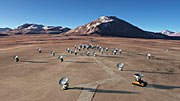ALMA’s Antennas
ALMA is the world’s most powerful telescope for studying the Universe at submillimetre and millimetre wavelengths, on the boundary between infrared light and the longer radio waves. However, ALMA does not resemble many people’s image of a giant telescope. It does not use the shiny, reflective mirrors of visible- and infrared-light telescopes; it is instead comprised of many “antennas” that look like large metallic satellite dishes.
ALMA comprises 66 antennas, 54 of them with 12-metre diameter dishes, and 12 smaller ones, with a diameter of 7 metres each.
ALMA 12-metre antenna dimensions:
- Height: 1470 cm
- Dish diameter: 1200 cm
The most visible part of each antenna is the dish, a large reflecting surface. Most of ALMA’s dishes have a diameter of 12 metres. Each dish plays the same role as the mirror of an optical telescope: it collects radiation coming from distant astronomical objects, and focuses it into a detector that measures the radiation. The difference between the this and an optical telescope is the wavelength of the radiation detected. Visible light, captured by optical telescopes, makes up just a small part of the spectrum of electromagnetic radiation, with wavelengths between roughly 380 and 750 nanometres. ALMA, in contrast, will probe the sky for radiation at longer wavelengths from a few hundred micrometres to about 1 millimetre (about one thousand times longer than visible light). This is known, perhaps unsurprisingly, as millimetre and submillimetre radiation, and lies at the very short-wavelength end of radio waves.
This longer wavelength is the reason why ALMA’s dishes are not mirrors, but have a surface of metallic panels. The reflecting surfaces of any telescope must be virtually perfect: if they have any defects that are larger than a few percent of the wavelength to be detected, the telescope won’t produce accurate measurements. The longer wavelengths that ALMA’s antennas detect mean that although the surfaces are accurate to within 25 micrometres — much less than the thickness of a single sheet of paper, the dishes do not need the mirror finish used for visible-light telescopes. So although ALMA’s dishes look like giant metallic satellite dishes, to a submillimetre-wavelength photon (light-particle), they are almost perfectly smooth reflecting surfaces, focusing the photons with great precision.
Not only are the dish surfaces carefully controlled, but the antennas can be steered very precisely and pointed to an angular accuracy of 0.6 arcseconds (one arcsecond is 1/3600 of a degree). This is accurate enough to pick out a golf ball at a distance of 15 kilometres.
ALMA combines the signals from its array of antennas as an interferometer — acting like a single giant telescope as large as the whole array. Thanks to the two antenna transporter vehicles, astronomers can reposition the antennas according to the kind of observations needed. So, unlike a telescope that is constructed and remains in one place, the antennas are robust enough to be picked up and moved between concrete foundation pads without this affecting their precision engineering.
In addition, the antennas achieve all this without the protection of a telescope dome or enclosure. The dishes are exposed to the harsh environmental conditions of the high altitude Chajnantor plateau, with strong winds, intense sunlight, and temperatures between +20 and -20 Celsius. Despite Chajnantor being in one of the driest regions on the planet, there is even sometimes snow here, but ALMA’s antennas are designed to survive all these hardships.
Download this video in other formats from the video archive.
The production of the antennas was shared between the ALMA partners. ESO built 25 12-metre antennas (with an option for an additional seven), with the AEM Consortium (Alcatel Alenia Space France, Alcatel Alenia Space Italy, European Industrial Engineering S.r.L., MT Aerospace). The North American partners also built 25 12-metre antennas with Vertex RSI, while the four 12-metre and twelve 7-metre antennas comprising ALMA’s Atacama Compact Array were built by NAOJ from MELCO (Mitsubishi Electric Corporation).
Apart from the obvious difference in size between the 12-metre and 7-metre antennas, careful observers will spot subtle differences in the antenna design from each partner. However, all the antennas are designed to meet the stringent technical specifications, and work together smoothly as parts of the whole. These state-of-the-art dishes, combined in a single revolutionary telescope, reflect the cooperative nature of the global ALMA project.

